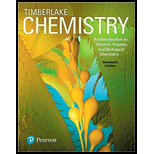
To determine: The bases in the parent and new strands
Answer to Problem 17.89UTC
Solution:

Explanation of Solution
As we know, in DNA, Guanine-Cytosine (G-C) and Adenine-Thymine (A-T) pair together and form hydrogen bonds between the two bases.
Based on the above fact, we can say that missing bases in the parent and new strands are
AGGTCGCCT
TCCAGCGGA
To determine: The m-RNA sequence using the new strand as template
Answer to Problem 17.89UTC
Solution:

Explanation of Solution
In RNA, the base present is Uracil instead of Thymine, which has a very alike structure to Thymine. As a result, the pairing of Adenine with Uracil (A-U) takes place by the same interaction that is hydrogen bonding as in the A-T base pair.
Based on the above fact we can say that the m-RNA sequence would be AGGUCGCCU
To determine: The 3 letters symbol for the amino acids that would go into the peptide from the m-RNA in part b
Answer to Problem 17.89UTC
Solution: Arg-Ser-Pro
Explanation of Solution
A triplet codon is the consecutive three bases on RNA forming a genetic code. The representation of each triplet codon is an amino acid. The sequence of bases on RNA could be seen as sequence of triplet codons. Thus, an amino acid sequence can be determined by the sequence of three letter codons on m-RNA. Each three letter codons either codes for a specific amino acid or codes for a stop signal. In this m-RNA, AGG codes for arginine, UCG codes for serine and CCU codes for proline. So, the amino acid sequence would be:
Arg-Ser-Pro
Based on the explanation as provided, we can say that amino acid sequence would be Arg-Ser-Pro.
Want to see more full solutions like this?
Chapter 17 Solutions
Chemistry: An Introduction to General, Organic, and Biological Chemistry (13th Edition)
 ChemistryChemistryISBN:9781305957404Author:Steven S. Zumdahl, Susan A. Zumdahl, Donald J. DeCostePublisher:Cengage Learning
ChemistryChemistryISBN:9781305957404Author:Steven S. Zumdahl, Susan A. Zumdahl, Donald J. DeCostePublisher:Cengage Learning ChemistryChemistryISBN:9781259911156Author:Raymond Chang Dr., Jason Overby ProfessorPublisher:McGraw-Hill Education
ChemistryChemistryISBN:9781259911156Author:Raymond Chang Dr., Jason Overby ProfessorPublisher:McGraw-Hill Education Principles of Instrumental AnalysisChemistryISBN:9781305577213Author:Douglas A. Skoog, F. James Holler, Stanley R. CrouchPublisher:Cengage Learning
Principles of Instrumental AnalysisChemistryISBN:9781305577213Author:Douglas A. Skoog, F. James Holler, Stanley R. CrouchPublisher:Cengage Learning Organic ChemistryChemistryISBN:9780078021558Author:Janice Gorzynski Smith Dr.Publisher:McGraw-Hill Education
Organic ChemistryChemistryISBN:9780078021558Author:Janice Gorzynski Smith Dr.Publisher:McGraw-Hill Education Chemistry: Principles and ReactionsChemistryISBN:9781305079373Author:William L. Masterton, Cecile N. HurleyPublisher:Cengage Learning
Chemistry: Principles and ReactionsChemistryISBN:9781305079373Author:William L. Masterton, Cecile N. HurleyPublisher:Cengage Learning Elementary Principles of Chemical Processes, Bind...ChemistryISBN:9781118431221Author:Richard M. Felder, Ronald W. Rousseau, Lisa G. BullardPublisher:WILEY
Elementary Principles of Chemical Processes, Bind...ChemistryISBN:9781118431221Author:Richard M. Felder, Ronald W. Rousseau, Lisa G. BullardPublisher:WILEY





